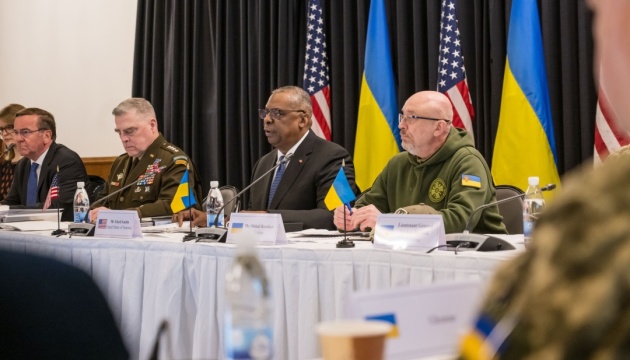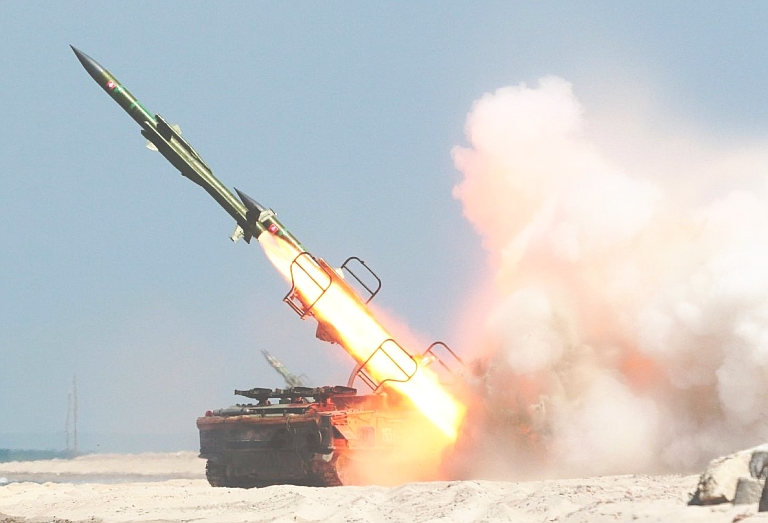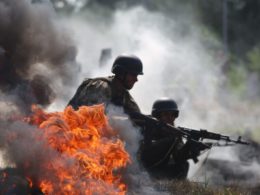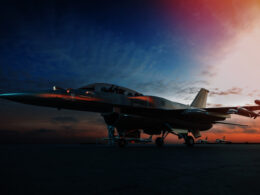Ukraine's western partners continue assembling weapons that Ukraine's Commander-in-Chief Zaluzhnyi says are essential for an offensive -- 300 tanks, 600-700 infantry fighting vehicles, and 500 howitzers -- but stopped short of supplying tanks. However, Ukraine starts calling for F-16 jets and long-range missiles.
Ukraine's Defense Minister Oleksiy Reznikov calls Ramstein-8 an "optimistic breakthrough" and lauds the decision to start training Ukrainian troops to use the Leopard tanks that Germany has not yet allowed to supply.
https://twitter.com/EuromaidanPress/status/1603433875975323648
Here are the main outcomes of the Ramstein-8 meeting for Ukraine that took place in Germany on 20 January, as per liga.net.
Tanks
Poland, Slovakia, and the Czech Republic have agreed to send German-made Leopard-2 tanks to Ukraine, and Finland could take part in technical maintenance. However, Germany does not yet give permission for their reexport and has not started supplying them itself, despite international pressure on its leadership ahead of the meeting.
German Chancellor Olaf Scholz claims that the decision to supply Leopards will be taken in accord with other allies, but Ukraine's Defense Minister Oleksiy Reznikov sees an "optimistic breakthrough" in the permission for countries that have Leopards to start training Ukrainian troops.
Apart from the Leopards, other countries promise Ukraine tanks, too:
- UK promises to give heavy Challenger 2 tanks
- France: wheeled AMX-10RC tanks, and maybe heavy Leclerc
- The USA sees no point in sending Abrams because of the difficulties in maintenance.
Armored vehicles and air defense
Ahead of Ramstein, Ukraine's partners increased aid in the direction of armored vehicles, artillery, and air defense:
- The United States, in two packages worth $5.5 billion, is giving Ukraine 109 Bradley IFV "tank killers," 90 Stryker armored personnel carriers, 100 M113 armored personnel carriers, more than 100 mine-resistant armored vehicles (MRAPs), 350 Humvees, missiles for HIMARS and NASAMS, 18 155-mm howitzers and 38 105-mm howitzers, and hundreds of thousands of rounds of artillery ammunition
- UK: 30 AS90 self-propelled artillery systems, about 100,000 artillery shells, a company of Challenger tanks, a hundred armored vehicles (including FV430 Mk3 Bulldog), 600 Brimstone missiles;
- Poland will equip and train a tank brigade with T-72s by the end of March;
- Denmark: 19 Caesar self-propelled artillery systems;
- Sweden: 155-mm Archer self-propelled artillery systems and up to 50 CV90 infantry fighting vehicles;
- Germany: 40 Marder infantry fighting vehicles, seven Gepard anti-aircraft guns, IRIS-T air defense systems;
- France: AMX-10RC wheeled tanks, Bastion armored vehicles;
- Canada: 200 Senator APC armored vehicles and NASAMS air defense systems;
- The Netherlands: a battery of Patriot air defense systems (two more were previously promised by the United States and Germany) and are ready to pay for the supply of Leopards.
Nine other countries promise to provide Ukraine with dozens of artillery units and armored vehicles and will seek to supply tanks: Estonia, Lithuania, Latvia, Denmark, Britain, the Netherlands, Slovakia, the Czech Republic, and Poland.
Western partners now believe in Ukraine's victory
According to Defense Express editor-in-chief Oleg Katkov, Ukraine's allies now believe it is capable of not only defending its territory but winning back land occupied by Russia, including occupied Crimea; this is why it now supplies infantry fighting vehicles. As well, they are sending more artillery systems. Earlier, they could not because they were limited by the question of producing enough munitions, a constraint that is now gone.
As well, Katkov says, Ukraine's partners take up a complex approach by providing ready solutions. For instance, soon, a brigade with 109 American Bradley IFV and 90 IFV Stryker can be formed. If adding 31 tanks and 30 155-mm howitzers, one gets nearly a full brigade.
For this, the Leopard tanks are extremely important: it is the battle tank believed to be the best fit for Ukraine and there are 2,400 of them in the inventories of NATO countries in Europe. Consultations with Germany to allow the reexport of Leopards to Ukraine will continue.
300 tanks for Ukraine: who could give it the gear to beat Russia
Trending Now
The new weapons will allow Ukraine to not only defend itself from Russia's attacks but go on the offensive, NATO Secretary General Jens Stoltenberg believes
. US Defense Secretary Lloyd Austin said there is "a window of opportunity" ahead of the spring to get Ukraine the capabilities they need to go on the offensive.
Meanwhile, US Chief of Staff Mark Milley told that militarily it would be "very, very difficult" for Ukraine to completely push Russia out of Ukraine by the end of 2023, but Ukraine could execute a successful operation to liberate some land depending on the training and equipment they receive in the next few months.
Talks to provide Ukraine with the needed tanks will continue and a tank coalition will be built, Mariusz Blaszczak, Poland’s defense minister, said. However, Germany will resist until the end, defense expert Oleksiy Melnyk told Liga.net. Melnyk believes that in the course of several weeks, it will finally agree. Defense Express editor Katkov also believes that Germany will eventually give in, as Ukraine's partners can use many levers of influence to prompt it to make the decision.
Already now, German Foreign Minister Annalena Baerbock has said
Germany will not stop Poland from sending Ukraine its Leopard tanks.
Zelenskyy has already asked his partners at Ramstein 9 to agree to supply Ukraine with F-16 fighter jets and long-range missiles.
This could happen. The Netherlands is ready to consider the transfer of F-16s if Ukraine requests them. Another sign that the supply of fighter jets to Ukraine is possible could be the transfer of Patriot air defense systems to Ukraine, Katkov said. They are needed to protect air bases that need to be prepared to receive Western aircraft from Russian missiles.
Washington understands that Ukraine needs long-range weapons, but so far has not provided ATACMS missiles for HIMARS with a range of about 300 kilometers.
Britain can show leadership on this issue, as it has already done with tanks. Defense Secretary Ben Wallace has spoken about the need for long-range missiles, and CNN sources say that some British officials are open to supplying long-range systems.
The ATACMS issue is highly politicized, Katkov says. He predicts that Ukraine is likely to quietly receive air-launched cruise missiles, like it was with Harm anti-radiation missiles. Only after Russians started publishing the serial numbers of the missiles did the West admit that they were sent to Ukraine.





